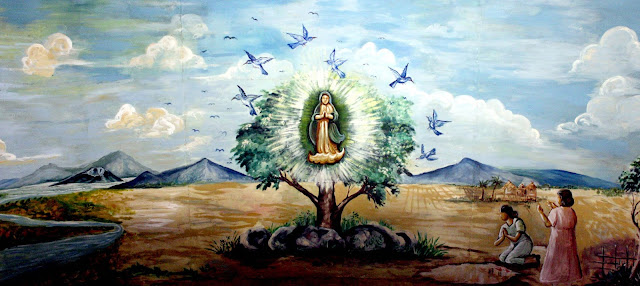Señor Santo Cristo de San Juan - San Juan City's beloved Señor
 |
| Señor Santo Cristo de San Juan |
The Señor Santo Cristo became the silent witness of the rich history of San Juan from a small barrio to a highly urbanized city and the city's role in the Philippine Revolution and He continues to watch over and protects His children over the centuries.
The image
The image of the Santo Cristo was that of Our Lord Jesus in His Crucifixion. In this image, He sports a set of Tres Potencias and He is vested with a set of tapis made from different fabrics and done with different styles of embroidery that are given by devotees as ex votos. The legs and feet of the image was recently covered with glass to preserve and protect the image from damage due to constant caresses of his devotees over the years.
 The Origin of the Señor
The Origin of the SeñorIn 1641, Fr Sebastián de Oquendo, OP, the Prior of Santo Domingo monastery in Intramuros, decided to send to San Juan the image of the Santo Cristo that was then venerated in Binondo Church (another Dominican Mission). The venerable image was brought to the reconstructed church in San Juan and placed on the main altar, displacing the image of John the Baptist, since the image, which was "nine palmos in height" (approx. 1.80 metres) would not fit. From then on, devotion to the Santo Cristo spread to nearby communities.
The shrine itself gained popularity when the image began to perform miracles, thus earning the shrine the name Santuario del Santo Cristo. News of the image's miracles spread to Manila and the surrounding areas, particularly the neighbouring Franciscan parish and town of Santa Ana, to which the present-day San Juan Mandaluyong once belonged to.
On May 3, 1924, the Feast of the Señor Santo Cristo, the image went out on procession for the first time since its enthronement in 1641. In the olden days, whenever there was a fiesta procession the image carried was the Crucifix that was kept in the sacristy of the old church and at present is venerated on Good Friday. The Santo Cristo was too heavy to be carried around.
In 1923, an andas was first comissioned and was used in the procession of 1924, however, they find it very difficult because of the weight of the Señor and the pilgrims who wanted to touch the Señor. It was later decided that an carozza was to be made for this purpose and this was crafted by Maximo
Vicente.
 |
| The Santuario de Santo Cristo of San Juan |
The Santuario de Sto. Cristo and its adjacent convent were built in 1602-1604 by the Dominican Fathers of the Holy Rosary Province on a site donated by Captain Julian de Cuenca. Before the Sto. Cristo was enthroned, St. John the Baptist was the titular of the church. The church and the convent were burned during the Chinese uprising of 1639 and the during the British occupation of 1763. After these political unrest, the edifices were rebuilt shortly.
In May 3, 1942, the Santuario was erected as a parish. As years went on the church could not cope with the increase population of San Juan and the idea of enlarging the church was finally pushed through on February 16, 1963 when His Eminence Rufino Cardinal Santos blessed the cornerstone of the new Santuario. The present structure keeps the original façade of the church of 1774 and, though enlarged, retains the same inside and outside structures. In the Jubilee Year of Mercy
 Papal Recognition
Papal RecognitionThe Confraternity of the Santo Cristo was established and approved by Pope Innocent X in 1648, roughly 45 years after the arrival of the Dominicans in San Juan. Prominent citizens of Manila and other towns became members of the Confraternity and made yearly pilgrimages to the shrine. Others decided to settle in the vicinity of the shrine, forming the nucleus of the present city of San Juan.
The Devotion
The Feast of the Señor Santo Cristo is celebrated every May 3, the Traditional Feast of the Invention of the Cross where St. Helena found the Holy Cross of Christ in the rubble located near Mount Calvary. Pilgrims flock His Shrine, especially on his feast day to join his annual procession with the attendance of thousands from San Juan and other parts of Metro Manila and some provinces.
The devotion to the Señor shows how much Christ cared so much for our salvation, In the case of the this image, it demonstrates his love to all of us that he bore until his humiliating death on the Cross and he used this particular image as an instrument of to brought forth graces to those trusts his love and mercy. May the devotion to the Señor Santo Cristo leads us to meditate on his Passion that saved all us from eternal damnation.
Reference:
Eladio Neira, OP. The Full History of Santuario del Sto. Cristo Church"(PDF). Santuario Del Sto. Cristo Parish. Retrieved 22 November 2015.
Jesus Prol, OP. The History of Santuario del Sto. Christo Church. Santuario Del Sto. Cristo Parish. Retrieved 10 May 2017.





Comments
Post a Comment